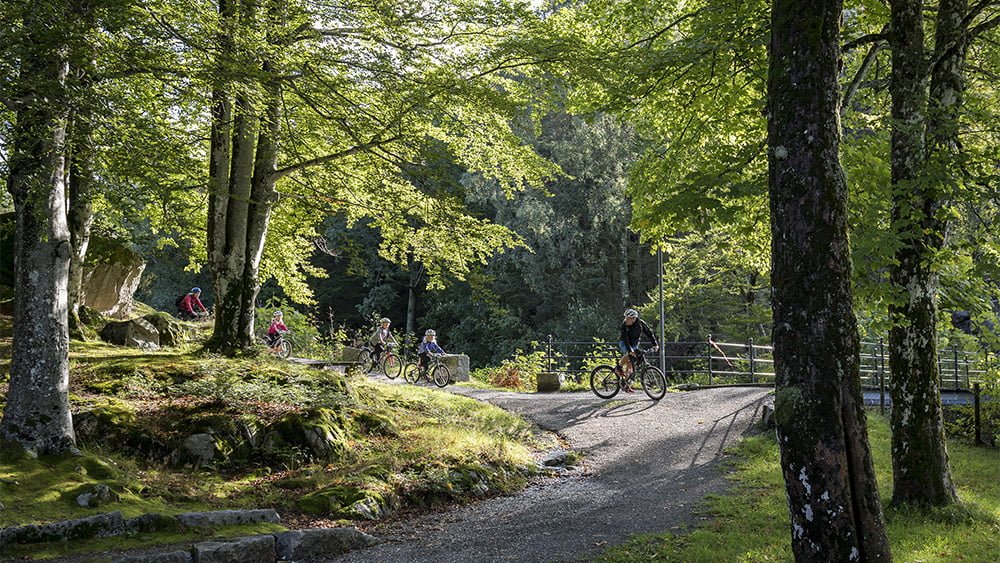Egersund city center has got a new attraction. (Photo: Arne Ove Østebrøt)
Live well in the Egersund region
The Egersund region and the town of Egersund are situated in the beautiful Dalane area and serve as a central hub with excellent bus and train connections. Here, you can live, work, and thrive centrally, with everything you need right outside your door.
With easy access to Stavanger Airport and well-connected train routes via Jærbanen and Sørlandsbanen to Stavanger, Kristiansand, and Oslo, getting in and out of Egersund is a breeze.
With around 15,000 inhabitants, Eigersund is the largest of the four municipalities in the Egersund region. There are 24,000 residents in the region. In a region with an increasingly diverse business environment, there are good opportunities for employment for both.

The square in downtown Egersund was upgraded in 2023 with new benches and a splendid fountain that lights up during the dark hours. (Photo: Arne Ove Østebrøt)
Egersund, a delightful and colorful coastal town, often referred to as the “Southern Gem” of Western Norway, is a city of rich history and tradition. Celebrating 225 years of city status in 2023, Egersund is renowned for its well-preserved wooden architecture, offering a unique blend of heritage and innovation.
The Egersund region offers varied nature, a diverse cultural life, and excellent recreational opportunities with many activities and festivals for children, youth, and adults.


Kjervall – great hiking area.
Skadbergsanden.
The Egersund region is closely connected to the shared housing and job market in South Rogaland, with the significant opportunities it entails.
Surrounding Eigersund municipality are the municipalities of Sokndal to the south, Lund to the southeast, and Bjerkreim to the northeast. All four municipalities in Dalane are part of the Egersund region.
the unique UNESCO landscape
Nowhere else on Earth will you come closer to a real lunar landscape than in Magma UNESCO Global Geopark. The distinctive lunar-like landscape is due to a rare rock type – anorthosite, which is the same type of rock found on the moon.
In this area, you can experience geology of international importance, recognized by UNESCO, as well as historical wooden towns, stunning coastal scenery, vibrant culture, and delightful walks through the lunar landscape.


Trollpikken.
Sogndalsstrand.
GOOD HIKING OPPORTUNITIES AND LOVELY ATTRACTIONS
The Egersund Region offers stunning hiking and natural areas year-round, whether you prefer gravel paths, forests, mountains, or coastal walks. There are excellent hiking trails in the mountains and scenic paths in varied landscapes. During winter, enjoy excellent skiing opportunities.
The rock formation known as Trollpikken is located in Eigersund. Trollpikken gained worldwide fame in 2017 when it was cut down from the mountain where it had been hiding for almost 10,000 years. There are well-established trails to the re-erected Trollpikken, making it easily accessible for visitors.
The road over Tronåsen, on the border between Rogaland and Agder, is one of the tourist attractions in Lund. Tronåsveien, constructed as part of the main road of Vestlandet, was completed in 1844. The steep and winding road is now protected. Annually, the Tronåsen Grand Prix is organized by enthusiasts and local organizers.
Eigerøy Lighthouse is the oldest cast iron lighthouse in Norway and was automated in 1989. As a proper lighthouse should, it emits light from a system of lamps and lenses and is part of an advanced international system of sea markers along the entire coast.
The 17-kilometer-long Ørsdalsvatnet is one of the tourist attractions in Bjerkreim. Around the lake, there are beautiful hiking areas and abandoned mountain farms. In Ørsdalen, guided tours are available to a restored molybdenum and tungsten mine. The day trip cabin Kaurebu, opened in 2022, has become a very popular hiking destination. It serves as a gateway, allowing more and more people to enjoy the nature around Ørsdalsvatnet. The MK “Ørsdølen” was the last boat to operate in organized scheduled traffic on a lake in Rogaland. Now, the boat is used for tourist traffic and for charter trips on Ørsdalsvatnet.
Sogndalstrand with its charming buildings and cultural landscape is protected by law by The Directorate for Cultural Heritage. Fishery was vital for this coastal town. In the 1870s there were 20 shops, four bakeries, two spirits shops and four pubs. There was also a customs office, a bank, a spinning mill, a sail port, a post office, a midwife, a bailiff, and even a prison. This was ofen used as a drunk cell when things got out of hand on the market place on Saturday nights. The industrialisation of Norway also affected Sogndalstrand. People moved to the cities and the herring disapeared, which caused difficulties for the fishermen. The shops closed, one after the other, and Sogndalstrand was gradually becoming a ghost town. The houses decayed and the last shop was closed in 1994. Today there are about 80 people living in Sogndalstrand. Many of the old houses are used as holiday homes.
In this idyllic setting, Sogndalstrand Kulturhotell operates in newly restored wooden buildings from the 1700s to 1800s. There’s also a gallery, a general store, a fishing museum, and an outdoor amphitheater where concerts and plays are held.




